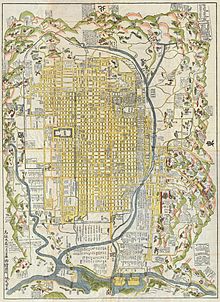Heian-kyō
Heian-kyō ( Japanese 平安 京 , literally: "Imperial residence of peace and tranquility") was the original name for today's city of Kyōto , which was the seat of the imperial court from 794 to 1868 and thus the capital of Japan .
Heian-kyō gave its name to the Heian period (794–1185) and brought court life to a unique bloom.
history
Emperor Kammu moved the seat of government from Heijō-kyō (now Nara ) to Nagaoka-kyō in 784 in order to master the excessive political influence of the Buddhist sects and to strengthen the Ritsuryō system. After the assassination of the biggest proponent of the move, Fujiwara no Tanetsugu , the exile and the death of Prince Sawara , a brother of Kammu, as well as several natural disasters that were interpreted as Sawara's revenge, the further development of the capital came to a standstill. Wake no Kiyomaru advised the emperor to build a capital in the large basin of the Yamashiro province between the Katsuragawa and Kamogawa rivers - protected from typhoons by the surrounding mountains. Fujiwara no Ogurimaru received the imperial order in 793 to build the new capital in a checkerboard pattern based on the example of the Chinese capital of the Tang Dynasty Chang'an , today's Xi'an . With the exception of an interruption in 1180, when the capital was moved to Fukuhara-kyō for half a year , Heian-kyō was the capital of Japan for more than a thousand years. With the end of the Gempei War in 1185, the city lost its status as a political center when power passed to the shoguns who resided in Kamakura , the Ashikaga shoguns had their headquarters again in Heian-kyō from 1338 until the Tokugawa shogunate from 1603 the seat of government finally came to Tokyo (then Edo ).
The initially unofficial name Kyōto ( 京都 , "capital, imperial residence") was already in use for the capital Heijō-kyō during the Nara period and replaced the name Heian-kyō by the end of the 11th century .
Construction and palace
In the rectangular area of around 4,500 m (east-west) by 5,200 m (north-south) there were no Buddhist institutions apart from the two state-run temples at the southern gate, the Sai-ji ( 西 寺 ) and the Tō-ji ( 東 寺 ) allowed. The Heian Palace ( Daidairi ), which burned down in 1227, was located in an inner rectangle at the northern "head" of the city.
The main street Suzaku-ōji ( 朱雀 大路 , dt. "Main Street of the Red Bird "), which ran from Suzaku-mon at the imperial palace to the south to Rajō-mon , divided Heian-kyō into a “left district” ( Sakyō ) and a "Right District" ( Ukyō ). The larger east-west streets Ōji were numbered from north to south to 9 ( Kujō-Ōji ). The names and floor plan have largely been preserved to this day , even after the great destruction of the Ōnin War in the 15th century.
As the adjacent map of Kyoto shows, only the Sakyō was left by 1910. In return, the city had expanded to the east and north over the old city limits during the Muromachi period. The imperial palace in the black rectangle had long since disappeared, today's (red rectangle) is on the eastern edge of the old city. The train station (in Orange) is between the 8th and 9th cross streets.
Individual evidence
- ↑ in E. Papinot: Historical and Geographical Dictionary of Japan. 1910. (Reprint: Turtle Verlag, 1972, ISBN 0-8048-0996-8 )
Coordinates: 35 ° 0 ′ 0 ″ N , 135 ° 46 ′ 0 ″ E


